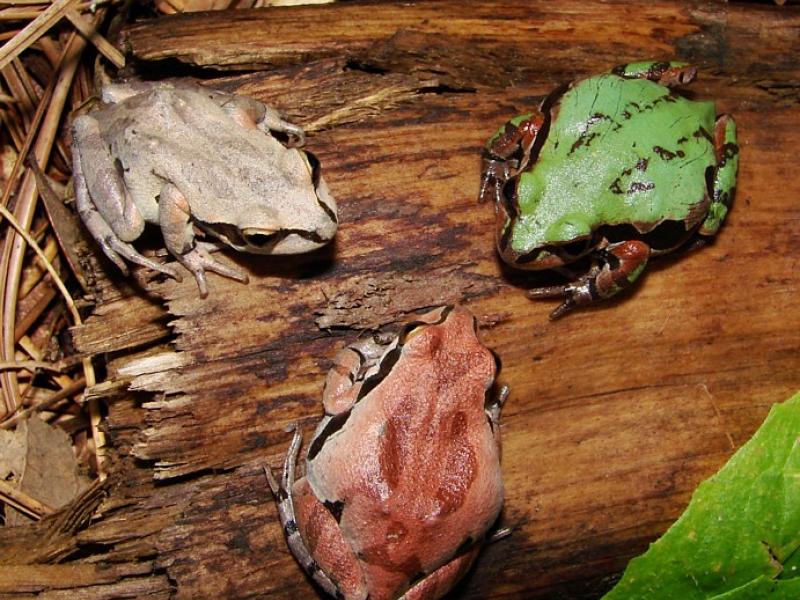Photo Credit: Roger Birkhead | Photo Credit: Aubrey M. Heupel
SCIENTIFIC NAME:
Pseudacris ornata
STATUS:
Uncommon to locally common in Coastal Plain east of Cahaba and Alabama Rivers. Occurs west of Mobile Bay in southern Mississippi. Expected in Mobile and Washington Counties in Alabama. MODERATE CONSERVATION CONCERN.
DESCRIPTION:
A stout species and the largest chorus frog species in the southeast, reaching a maximum length of 1.6 in. This species displays a variety of background colors including gray, brown, reddish-brown, and even bright green. All individuals exhibit bold dark stripes through the eyes and along the sides, but the pattern along the sides may be broken. The forelimbs and hind limbs are marked with dark bars, and most individuals exhibit a dark triangle on top of the head between the eyes. Dorsal (back) patterns may or may not be present. The groin and thigh areas are bright yellow.
DISTRIBUTION:
Ornate chorus frogs are a Coastal Plain species, ranging from North Carolina, south through North Florida, and west to extreme eastern Louisiana. In Alabama, this species is restricted to the southeast region of the state, extending into Mississippi only along the coast.
HABITAT:
The ornate chorus frog inhabits ephemeral (temporary) wetlands and surrounding uplands associated with Coastal Plain forest habitats such as sandhills, pine flatwoods, and upland pine forests. Breeding habitats include cypress ponds, wet meadows, Carolina Bays, barrow pits, and roadside ditches. During the nonbreeding season, these frogs hide in burrows or under logs and debris in the adjacent uplands.
FEEDING HABITS:
Feeds primarily on small insects and other invertebrates.
LIFE HISTORY AND ECOLOGY:
Ornate chorus frogs are most active during the winter months and breeding occurs from December to March with the peak activity depending on rainfall. Males arrive at the breeding ponds before the females, so calls may be heard as early as October and November after significant rain events. Males advertise to females while floating or perched just above the water on aquatic vegetation or floating debris. Their call is a metallic peeping that has been compared to the sound of a hammer hitting a chisel. It is similar to a spring peeper’s call but differs in that is a sharper, shorter note that does not increase in pitch.
Females lay eggs in clumps of 20-100, attaching them to aquatic vegetation. The tadpoles hatch within a few days and will transform into froglets within 3 months. Tadpoles have a high tail fin with two gold stripes usually present on the sides of the back with a dark background. Some individuals have a bicolored tail. Tadpoles can reach a length of 1.75 in. before transforming.
BASIS FOR CLASSIFICATION:
Declines of this species are occurring throughout much of its range. Loss of breeding habitat along with destruction and disturbance of the surrounding uplands during industrial pine farming are likely contributors. Ornate chorus frogs live in habitats that are predominantly fire dependent, and lack of fire in these systems can cause dramatic changes in wetland vegetation and water levels. These changes may cause the loss of populations in many areas where frequent (prescribed) fire does not occur. Pine plantation operations along with a restricted range in Alabama make this a potential species of concern for the state.
References:
Dorcas, M. and Gibbons, W. 2008. Frogs & Toads of the Southeast. University of Georgia Press, Athens, GA. 238 pp.
Jensen, J. B., Camp, C. D., Gibbons, W., Elliott, M. J. 2008. Amphibians and Reptiles of Georgia. University of Georgia Press, Athens, GA. 575 pp.
Mount, Robert H. 1975. The Reptiles and Amphibians of Alabama. Auburn Printing Company, Alabama. 347 pp.
Author: Aubrey M. Heupel, Wildlife Biologist, Alabama Partners in Amphibian and Reptile Conservation







